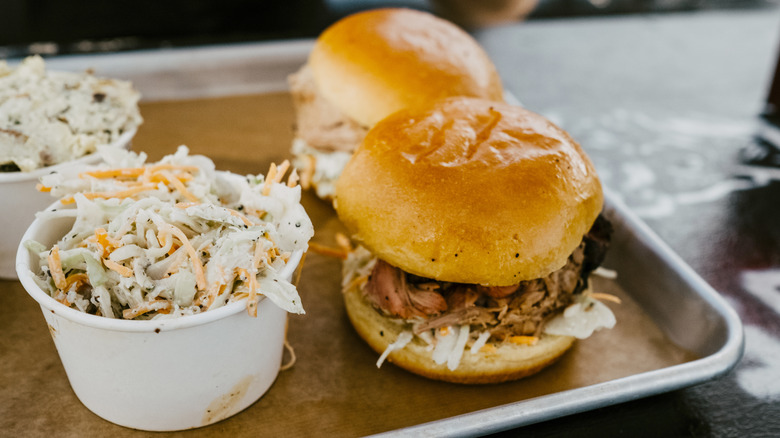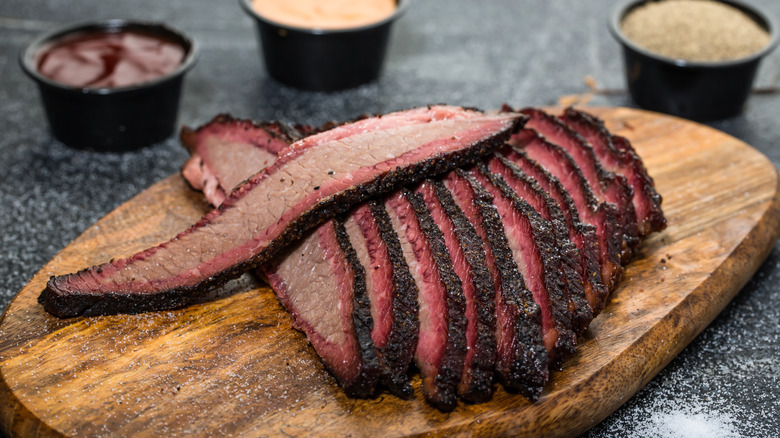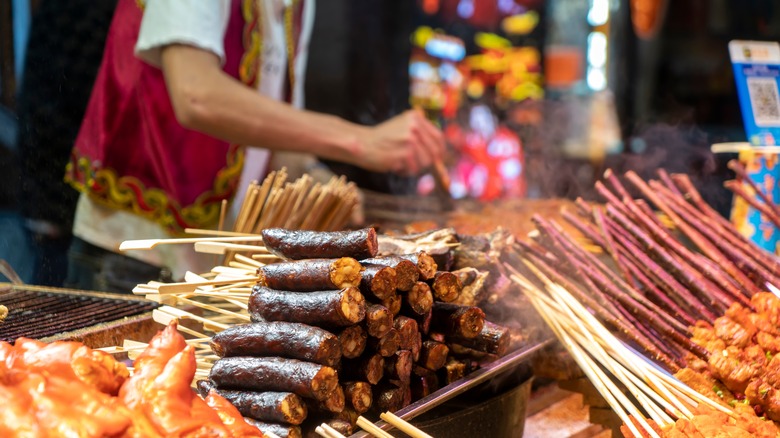Why You Should Never Eat At A BBQ Restaurant In A Shopping Mall
There are certain culinary phrases that should give one pause: gas station sushi, airplane food, all-you-can-eat anything, omelet station, and boutique sports bar are just a few, but today's focus is on mall barbecue. While good barbecue can be found almost anywhere, proper barbecue involves fire, smoke, and wood — chunks, chips, or pellets. None of those things are conducive to food courts. It's not impossible for a restaurant to be allowed to run a smoker in the parking lot, but chances are the meat was smoked elsewhere and transported in, leaving questions about its freshness and handling.
There are situations where this is acceptable, like catering or ordering to-go from a standalone barbecue restaurant. But that same place's stall at your typical mall food court is usually a satellite, doing little to no production. That's why you see so much fast food at airports, gas stations, and malls. It doesn't take much to fry chicken tenders or cook burger patties, but that's not the case with barbecue.
Franklin's Barbecue in Austin, Texas, famously serves its fare from 11 a.m. until it sells out. That scarcity drives demand somewhat, but the real reason for the high demand is that its briskets are consistent and beautiful. Mass producing them to sell offsite risks compromising the quality of the meat. Mall barbecue might do in a pinch, but you might honestly be better off with a McRib, because it was designed to be the same whether at a mall, gas station, or drive-thru.
Why doesn't barbecue have a long shelf life?
Shredding or slicing meat ahead of time is easier than doing it onsite, but once you cut brisket, ribs, or pull pork or chicken, the clock starts ticking on how long the food will stay juicy. There's nothing worse than dry 'que, which could explain why some places offer six different sauces. While the number of sauces might not necessarily indicate quality, a barbecue joint willing to serve you a piece of meat without a side or drowning it in sauce is a confident — and brave — barbecue joint.
Certain foods hold up better for to-go orders than others, and barbecue falls into the category of "travels well," but is prone to drying out upon reheating, requires further doctoring. Unlike pizza, it isn't great cold. So while food at a satellite location might be good the same day it was delivered, it might not get daily deliveries, or could be serving leftovers before the fresh batch arrives.
Another factor is the cook time. There's no way to fire barbecue to order. Smoking takes anywhere from two to 12 hours, and the meat can only be held hot for so long. While it might survive in the hotbox better than most foods, there's no way to guarantee the meat will retain its best qualities days after cooking.
Be practical, not judgmental
Some of the best racks of ribs in Kansas City, Missouri — or anywhere — come out of a gas station. Joe's Kansas City Bar-B-Que is a chain, but it's also a shining example of how to serve high volumes while ensuring consistency. Part of its success comes from how quickly it turns over ribs and burnt ends, and another part is how it holds food in a way that makes it hard to tell how long it's been between smoker and table.
There are also food courts and food stalls that serve great barbecue. They might exist in Seoul, South Korea, and other parts of Asia, but they do exist. Barbecue at a food festival or block party is likely more fresh than something from an overly sanitized corner at the Oakbrook outlets. The guy cooking jerk chicken in a converted oil drum is probably a safer bet than Garrett reheating two-day-old pulled pork shoulder in a microwave and drowning it in sauce at Crossroads, Westroads, or Midtown Crossing. Remember: Where there's smoke, there's barbecue.



